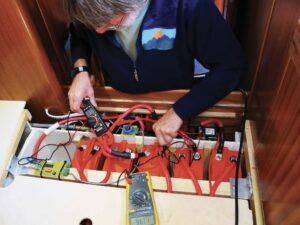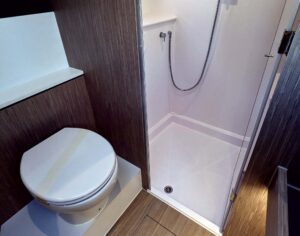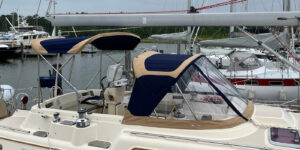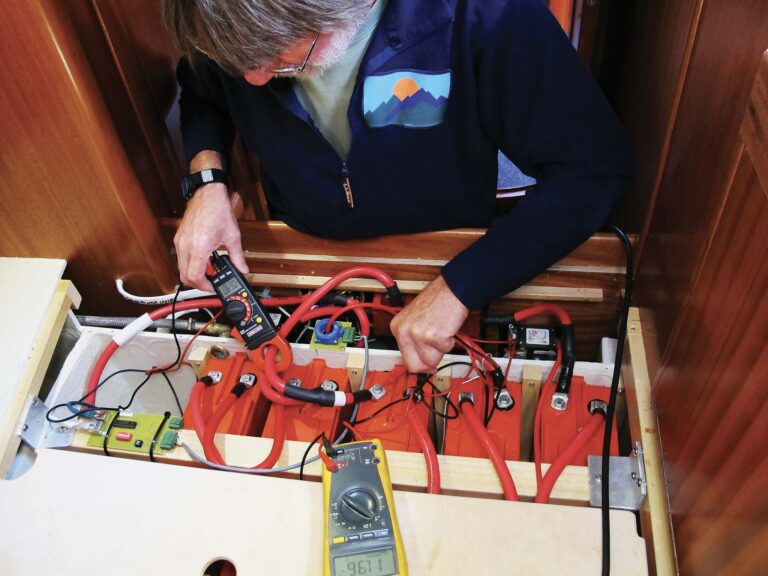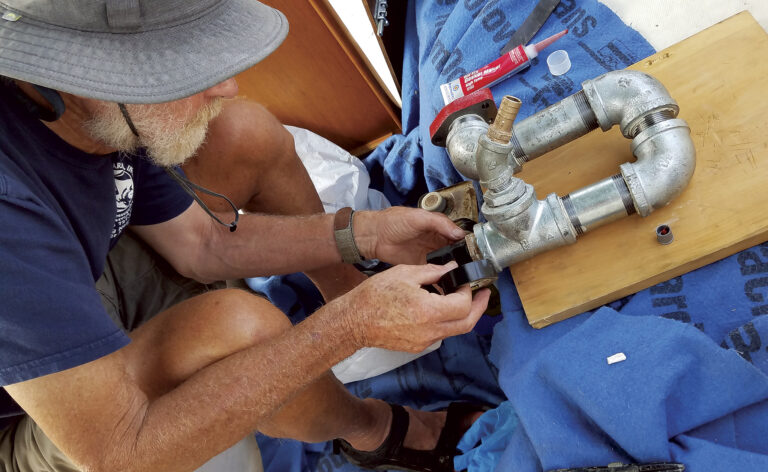
If there’s one thing as certain as death and taxes, it’s that sooner or later every sailor who owns a boat bigger than a trailersailer will be faced with the unappealing chore of having to go up the mast. Murphy’s Law will make sure of that. Riggers don’t come cheap, and if you have the requisite head for heights and are capable of doing what needs to be done there’s no reason why you can’t attend to the matter yourself.
The question remains of how you’re going to get up that stick. The time-honored way (and to me, the preferable way) is to have a brawny shipmate crank you up in a bosun’s chair—that’s if you can’t persuade some lightweight crew to don the chair while you do the cranking—but what if you’re alone on board or the shipmate isn’t strong enough?
We tried four different products aimed at helping solo sailors to ascend a mast. Here’s what we found.
ATN Mastclimber (atninc.com, $485). This variant of the ascenders technique has been around for a long time, and regular boat-show goers will have seen ATN’s Etienne Giroire going up and down his dummy rig with practiced ease. Indeed, using the Mastclimber is simplicity itself. First, rig a line to ascend upon. Typically, this will be the main halyard. Make it fast somewhere close to the base of the mast and crank the halyard tight with a winch. (ATN used to specify a static line, but its latest ascenders will fit any size of halyard). Seat yourself in the included bosun’s chair and clip its attached ascender onto the halyard. Then clip on the second ascender, which has a pair of webbing foot straps attached to it. Up the halyard you go, pushing yourself up with your feet while sliding the top ascender up the halyard, then sitting back in the bosun’s chair while you slide the lower ascender up. Repeat until you’re where you want to be. To descend, you reverse the procedure by releasing each jammer in turn and sliding it back down the halyard.
Verdict: A simple system that works well, allowing you to swing away from the mast to check spreader ends and get your head and shoulders above the masthead. The bosun’s chair is comfortable and adds a feeling of security. Unlike the two mast ladders we look at below, you don’t need to remove your mainsail sliders to make it work. Be warned, though, unless you’ve been practicing your squats, it’s hard work pushing your weight up the halyard. Unless you’ve cranked the halyard super-tight, your body weight will also swing you back and make it more awkward to ascend and descend.

Kinleven Marine mast ladder (kinlevenmarine.com, from $280): This British product is made to measure for your boat; you send the makers your P (boom to masthead) dimension and the size of the slot in your mast so they can install the correct sliders. It can even be used in the slot of an inmast furling spar. The rungs are made from a hard ABS material connected to each other with color-coded webbing. If your boat has aft-swept spreaders, Kinleven will even make your ladder with standoffs to allow its rungs to clear them. To use, the stacked ladder is simply lifted to the masthead. Once there, it is released with a pull on a line from the deck so that the rungs rattle down the mast under their own weight. This is a heavy-duty piece of gear and felt reassuringly safe when used with a belt around the mast and a safety line rigged.
Verdict: This is a rugged item that will serve you well for many years. It felt sturdy and secure and was very easy to use once rigged, with the solid rungs lending a sense of security. It is, however, a little heavy and bulky when stowed, making it perhaps best suited to boats over 40ft or with lots of stowage space. The price depends on the length. Shipping from the UK can also be expensive.
Mast Mate (mastmate.com, from $280): Made from tough 2in-wide nylon webbing, the Mast Mate is about as simple as a mast climbing device could be. The webbing steps are 17in apart, and there’s a grommet just below each step to which a plastic sail slide shackle is attached. There are four standard lengths, from 27ft to 50ft. The customer provides the slides or slugs to suit the mast track or luff groove on the boat. The track is hauled up the mast with the main halyard as the slides are fed into the mast gate. In operation, I found that a tight downhaul added to the sense of safety. I went up the mast quickly using the combination toolbag and safety belt ($70) to hold me. Being an abject coward with a hatred of heights, I also used a safety line, which came in handy when I had to unclip the safety belt in order to lean out and reach the spreader ends.

Verdict: Tough, functional and easily stowed, the Mast Mate does its job well. You need to wear sturdy shoes or your feet will feel the pinch on the way up and down. However, the two topmost steps have stiffeners in them as you may be standing there for some time while you work on the masthead. If your spreaders are long, you won’t be able to reach them and work with both hands unless you have a safety line rigged so you can lean out from the mast.
Mast Steps (from $25, various makers): As seen on numerous salty bluewater cruising boats, mast steps are a fine way to scale your rig without assistance. I’ve climbed several step-equipped masts, and while I can’t say I enjoyed the experience more than any of the other methods, I couldn’t fault their functionality. There are two kinds of mast step—the ones that fold up out of the way, and the ones that don’t. Both offer secure footing and a fast route to the top, provided you use a safety line.
Verdict: If I had a salty bluewater boat, I would definitely equip it with mast steps. You can’t beat their simplicity. However, the folding steps are expensive, while the fixed ones seem tailor-made to snag halyards, and of course installing both sorts involves drilling lots of holes in the mast. There’ll also be an increase in weight aloft and in windage.
Conclusion
These are not the only ways of getting up a mast on your own—there are other mast ladders on the market, for instance (like the Topclimber, another variant on the ascenders theme), and some sailors have contrived their own ingenious methods and equipment. However, any of these listed products will get you to your masthead in safety and with varying degrees of effort. Just make sure to read the instructions and apply a liberal dose of common sense.
The Safety Line
Confession—we used the topping lift, made fast to a safety harness and tended by a shipmate, as a safety line for the two mast ladders. I’ve used the ATN Mastclimber twice solo, each time with a safety line secured to the topping lift with a Prussik hitch. Having gained confidence in the ascenders, I probably won’t use one next time. However, I would not use a mast ladder or steps without a safety line.
August 2019

